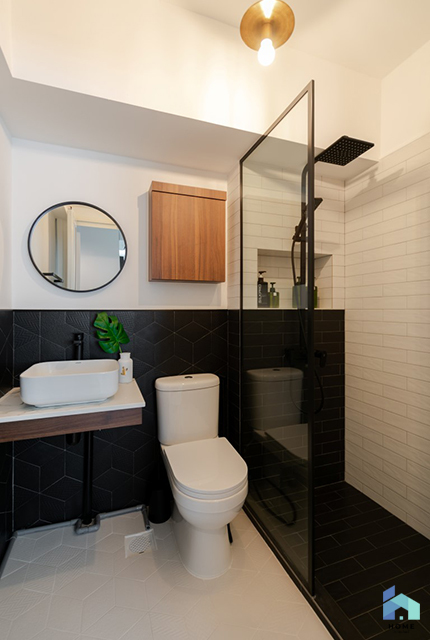A combination of the much loved Scandinavian style paired snuggly together with elegant Japanese elements, to create a minimal yet lived in look that you're guaranteed to love. If you want to know more about this latest trend and how to achieve it for yourself, read on.
Japandi what?
Japandi is a hybrid aesthetic of two different design styles, Japanese and Scandinavian. Although they come from different sides of the globe they both share similar principles in exercising minimalism. Japandi brings together the clean lines and rustic calm of Scandinavian minimalism and the traditional elegance of Japan. Combining the best of both worlds it draws on the Japanese notion of wabi-sabi; finding beauty in the imperfect, and hygge--a Scandinavian word for 'intentional intimacy' adopted by interior designers worldwide for a style that focuses on creating an atmosphere of warmth and comfort. Emphasising the importance of function-driven spaces Japandi is defined by a smattering of statement pieces rather than an abundance of décor, it is simplicity at its core but homely at its edges--a style that is both minimal, functional and welcoming.
This home at Miltonia is classic Japandi, with the warm woods complemented by the marble flooring. It's minimalist, choosing to showcase just one or two accent pieces, like the artwork, a small stack of coffee table books, and two fronds in a jar. Designed by Monocot Studio, this home exudes warmth and Japanese Zen in the low coffee table and what we assume is the television console (where the television is hid behind a sliding door). Definitely a restful and tranquil place to come home to every day.

 Image Credit: Monocot Studio
Image Credit: Monocot Studio
Warm it up
The neutral tones of Scandi style are now balanced with the rich, warm tones of Japan. Now we're not talking vivid reds and yellows but darker more sombre hues; navy blues, bottle greens and burnt oranges that contrast with a classic Scandi neutral palette. As colour helps warm up the generally cool tones of Scandi style, the rustic, eclectic nature of Scandinavian pieces helps to soften the hard, polished and darker tones of traditional Japanese furniture. The woods used have stepped away from ash and white pine into darker, warmer finishes like walnut and maple, juxtaposed with black accents and the compulsory pop of green from 70s inspired house plants, resulting in a minimal, lived in, visually interesting interior that warms the soul.
In this home at Waterway Sundew, Aart Boxx has used several different shades of wood--dark oak for the doors, cherry wood for the dining table and the bench, and a greyish driftwood like colour for the floors.The living room has subtler differences in the shades, the coffee table a lighter and pinker hue than the cherry wood television console. These complement each other and create a multi-textured home.

 Image Credit: Aart Boxx Interior
Image Credit: Aart Boxx Interior
In this home in Ang Mo Kio, designed by The Scientist, they've mixed up both the layout and the use of wood, preferring the dining table to be located closer to the windows rather than to the right of the living room, as is the more common configuration, and they've used a mixture of dark and light woods around the house, light wood for the dining table and chairs and a light walnut for the television console. This complements the colour scheme in the study, where the darker wood is used for the floor tiles and the lighter beech for the study tables. The accents of plum and charcoal give it a pop of colour.

 Image Credit: The Scientist
Image Credit: The Scientist
For a dose of colour, add a muted green to the walls, which will complement your display shelf full of your favourite items perfectly. This home at Everton Park, designed by Monocot Studio, embraces the use of dark woods, and the muted crocodile green that runs throughout the home, keeping the colour scheme consistent and brightening up the space. We love the simple side table-shelf on beside the bed.

 Image Credit: Monocot Studio
Image Credit: Monocot Studio
Mix it up
Functionality is still key within the Japandi aesthetic with a few statement pieces taking centre stage as opposed to an abundance of décor that may clutter or distract. The casual furniture forms of Scandinavian design and the intricate lines of Japanese aesthetics create a style that is altogether gentle and elegant. As both Scandinavian and Japanese furniture is so easily identifiable it's smart to use a mixture of both styles, combining light and dark woods with a contrast of pieces, doing this enables you to drive home that harmonious juxtaposition and a delightfully diverse sense of texture.
One example is this project by Homevista, at Telok Blangah, which has its television and sofa close to the ground, something that is a common sight in most Japanese homes, while creating a comfortable and warm atmosphere with its use of a black textured rug, lots of comfy cushions and a throw. The bathroom is also kept simple yet striking with its cubic black-and-white tiles and the niche carved out in the bathroom for easy access to their products. 

 Image Credits: Homevista Pte Ltd
Image Credits: Homevista Pte Ltd
Style it up
As an ultimately more minimal and organic aesthetic it's key to style your home with practical textiles, woods and multi-functional pieces. This is a style that celebrates functionality and carefully considers every item within the home--think contrasting colours, natural throws and the usable items like bowls and trays used as decorative items. Focus on practicality but most of all comfort, mixing both styles for a scaled back, luxurious yet homely feel. Whatever styling items you choose, put emphasis on natural elements such as rattan, linen and leather.
Designed by 0932, we love the wooden frame that leads to the large floor-to-ceiling windows with the quintessential black frame. This space is multi-functional and can transform from a seating area to a working space with just a few adjustments (like bringing the coffee table over to the windows). A textured rug, fabric sofa and a throw add a cosy feel to the home. Another way to do this is to add curtains to the home, whether it's in the bedroom or as a covering for your shelves.




 Image Credit: 0932
Image Credit: 0932
For those of you that enjoy the minimal but are looking for a little more soul, by pairing the best of Scandinavian and Japanese designs this look might just be the peak of inviting simplicity. What do you think of the Japandi trend?
More Inspiration:
Some of the best minimalist homes in Singapore for you to emulate.
Love all things Muji? Here's how you can build your entire interior design aesthetic around it.
Scandinavian homes need not be boring, nor expensive. See these homes under $40,000.
Like what you've read? Get a free and personalised recommendation for interior designers from us, and redeem $500 Harvey Norman shopping vouchers. Also, remember to save the date for our next Home by Hitcheed Meet and Greet on 8-9 December, 2018, at Suntec Convention Centre, Level 3 Concourse!
![Hitcheed Private Limited [SG]](/assets/homebyhitcheed-728d385d18758a2cb036e11bf01bab977b3b6376ddfdd356b7e5dbe095de874e.png)


